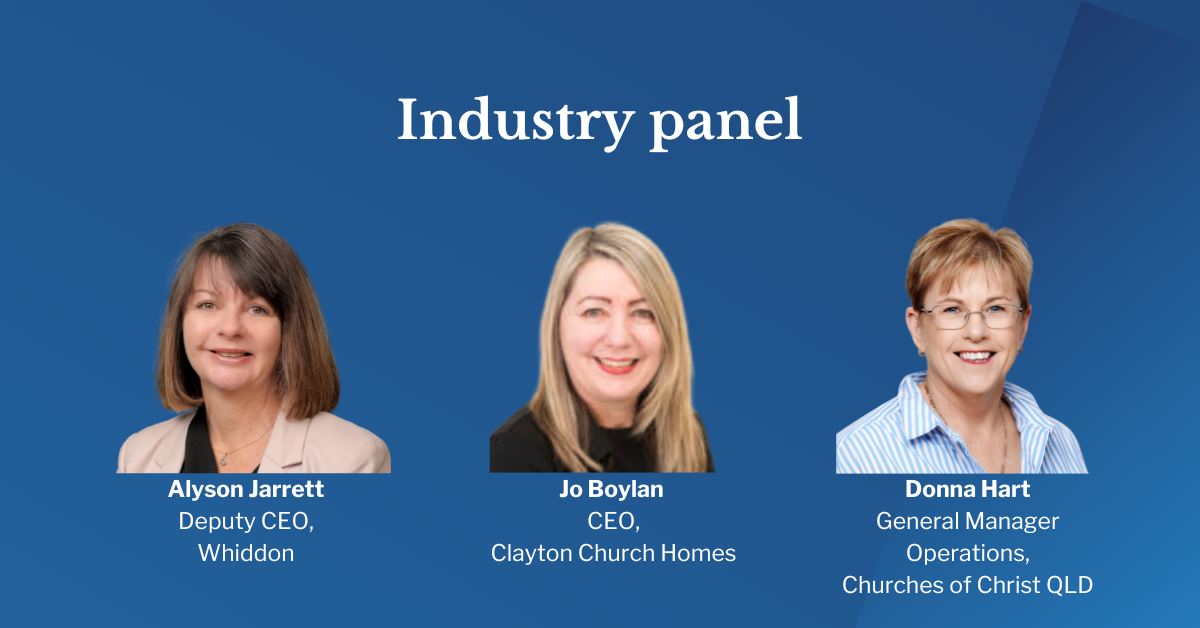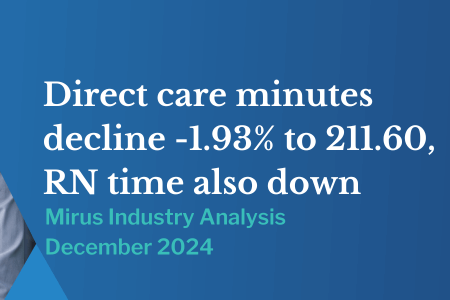3 aged care leaders share practical solutions to care minute compliance
April 15, 2025 | Care Minutes

By Dotti Gill, Marketing Manager
The AN-ACC framework’s care minute requirements have compelled aged care providers to balance compliance with financial sustainability. However, workforce shortages, limited budgets, and evolving resident needs present significant challenges. In a recent webinar, we spoke with three executives—Alyson Jarrett, Deputy Executive Officer at Whiddon Group (NSW); Jo Boylan, Chief Digital Officer at Clayton Church Homes (SA); and Donna Hart, Chief Director Officer at Churches of Christ (QLD)—who shared their experiences, challenges, and practical solutions for effectively meeting care minute targets.

Experiences with care minute compliance
Alyson’s perspective: Strengthening staffing at Whiddon Group
Alyson reflected on Whiddon’s journey since AN-ACC began in October 2022—a time still impacted by COVID’s aftermath. “It was an interesting journey,” she noted, recalling the staffing difficulties of that period. A pay increase in October 2023 brought some relief, but earlier strategies included sign-on bonuses, retention payments, refer-a-friend programs, and relocation support to stabilise the workforce and reduce reliance on agency staff. Rural areas proved more challenging than metropolitan ones.
Migrant nurses became a crucial part of Whiddon’s workforce strategy. “That’s been a really big part of securing registered nurses,” Alyson explained. A dedicated education program helped integrate them into both homes and local communities. She emphasised the increasing complexity of resident care, requiring skilled staff. “It’s getting easier with increasing pay,” she added, but continuous improvement remains key to meeting care minute targets.
Jo’s approach: Teamwork and systems at Clayton Church Homes
Jo described the intense pressure her organisation faced across five sites and approximately 500 beds. “We came together as a team,” she said, explaining how they identified challenges and developed solutions. A refer-a-friend program, offering financial incentives for staff recruitment, proved highly effective. “Extraordinarily great,” Jo noted, though it required significant training. “I did a lot of the work of teaching the new staff myself.”
Beyond meeting care minute quotas, Clayton Church Homes introduced a positive ageing model, ensuring that additional staff contributed to improved mobility and resident engagement. “You had to take a systems-thinking approach,” Jo emphasised. Their clinical software provided live data, while weekly care minute meetings tracked AN-ACC progress. Centralised rostering and dedicated backfill staff—two to four per home—helped reduce agency reliance while maintaining morale and staffing stability.
Donna’s view: Overcoming rural hurdles in Queensland for Churches of Christ
Donna shared insights from Churches of Christ’s operations across Queensland, including its rural and remote locations. “We had a few additional challenges,” she said, particularly with recruiting registered nurses. To attract and retain staff, the organisation implemented housing incentives, competitive wages, and premium pay rates. Agency staff were initially necessary to fill gaps, though reliance on them continues in rural areas.
Recognising the need for a sustainable workforce, Churches of Christ re-evaluated its employee value proposition, appealing to purpose-driven individuals beyond traditional candidates. “Those people are probably not going to come with their certificates,” Donna explained, highlighting the importance of training investments. The organisation also prioritised developing internal RNs through incentives and qualifications, which has shown promising results. “It’s been a flurry of activity in the recruitment space,” she said, emphasising the need to adapt continuously to meet care minute demands.
Strategies for achieving care minute compliance
Alyson’s focus: Data and roster stability
Alyson underscored the importance of data visibility. “For the first time, we can monitor whether we’re providing the care we’re funded for,” she said, reducing risks of over- or under-servicing. Whiddon invested in daily care minute tracking systems and stabilised master rosters to align targets across quarters. “That provides a smooth roster for our people,” she explained, though adapting to evolving targets remains a challenge.
To enhance efficiency, Whiddon is transitioning to a hybrid rostering model, combining centralised management with site-level adjustments. Daily reporting supports decision-making around occupancy and leave. “It’s a lot of work,” Alyson acknowledged, but ensuring resident care consistency remains the priority.
Jo’s Method: Planning and pressure relief
Jo highlighted weekly care minute meetings as a key success factor. “We’re much more on task to fulfil those requirements,” she said, emphasising close coordination with site managers. To reduce RN workload, a customer journey team now handles onboarding—a task that counts toward direct care minutes. “That takes a lot of the pressure off,” she added.
Additionally, centralised rostering, structured inductions, and dedicated backfill staff have significantly reduced agency costs. “Supply and minutes don’t always equal cost,” Jo pointed out, stressing the need to prioritise contracted hours for efficiency.
Donna’s Strategy: Real-time decision support
Donna emphasised the value of equipping service managers with real-time data. “That can change very quickly,” she said, noting the need for agile rostering decisions. “Do I actually need to replace this shift?” is a constant consideration.
While this approach increases administrative work—especially for onboarding agency staff—it ensures compliance while maintaining financial stability. “We’re focused on meeting care minutes sensibly,” Donna said, reinforcing the balance between resource allocation and regulatory demands.
Looking ahead: Future priorities
The webinar highlighted a significant improvement in compliance rates—from two-thirds non-compliant in 2022 to three-quarters compliant by October 2024. Despite this progress, challenges remain. Each leader shared their next steps:
- Alyson’s outlook: Whiddon will fine-tune quarterly target alignment, expand support for migrant nurses, and advocate for holistic care recognition, integrating allied health and wellbeing teams. Trials—such as employing an occupational therapist—aim to enhance resident independence despite workforce shortages.
- Jo’s vision: Clayton Church Homes will further develop holistic care models, utilising exercise physiologists and gyms to improve resident wellbeing. She also emphasised stronger university partnerships, starting from first-year placements, to ease training burdens on providers.
- Donna’s plan: Churches of Christ aims to go beyond compliance, positioning care minutes as a baseline for trust with residents and families. Future efforts include sustainable workforce strategies, leveraging government and education partnerships, and demonstrating the sector’s value through improved resident outcomes.
You can watch the full recording of the webinar here.
Tools to help you manage your funding and care minutes for compliance
At Mirus Australia, we’ve developed a suite of tools to help aged care providers stay on top of funding and care minute compliance. Mirus Metrics gives you real-time insights into your AN-ACC performance and care minute requirements, while Care Minute Manager tracks daily care delivery against your quarterly targets to reduce compliance risk. And with the Cost of Gap report, you get a tailored snapshot of where funding and care minutes may be out of alignment—so you can take action with confidence.
Together, these tools give you the clarity and confidence to make informed decisions and stay ahead of compliance. Click any of the links above to find out more or request a call back.


